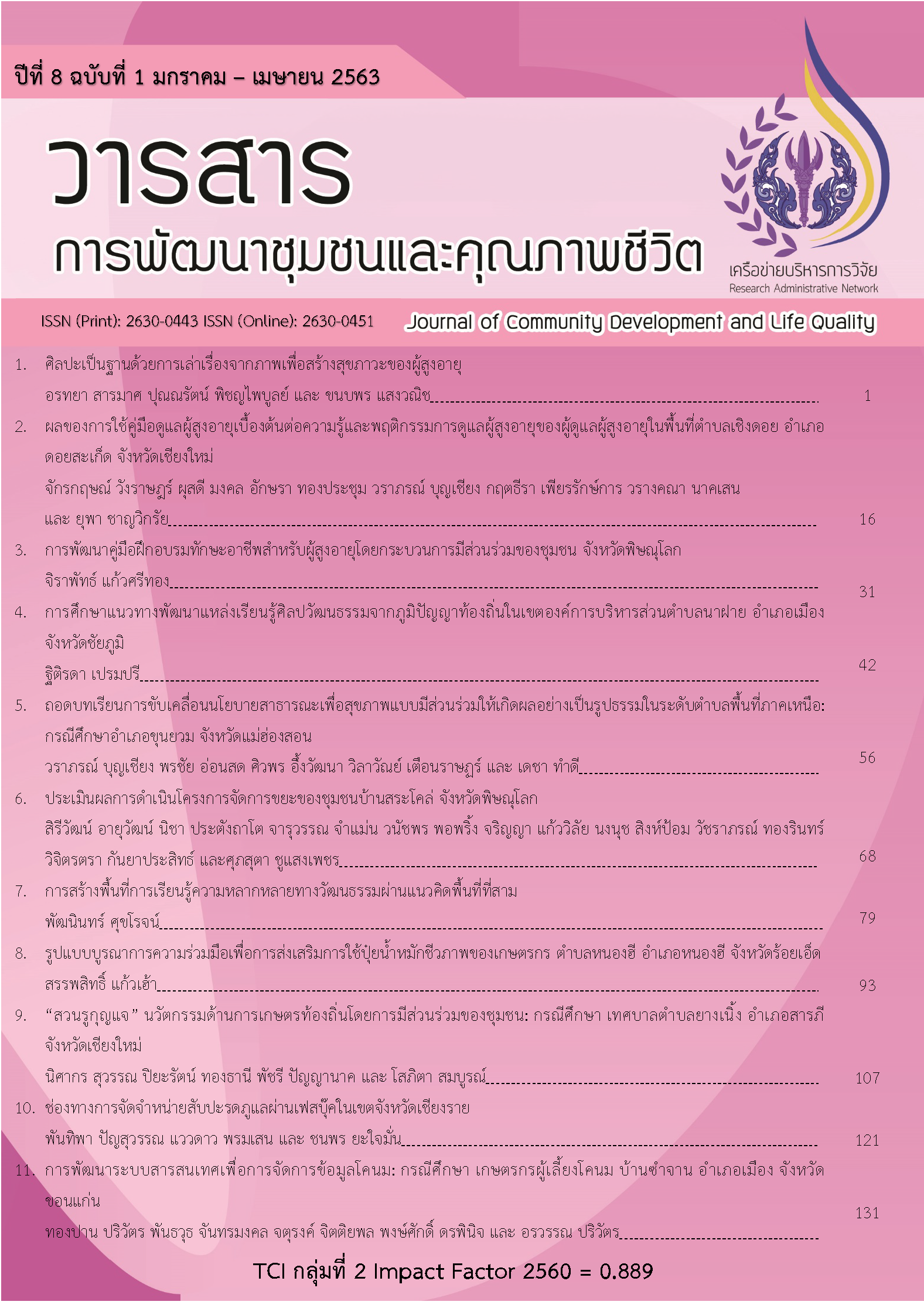การพัฒนาผ้ามัดย้อมสีธรรมชาติจากใบสัก ชุมชนบ้านแม่พวก ตำบลห้วยไร่ อำเภอเด่นชัย จังหวัดแพร่
Main Article Content
บทคัดย่อ
การวิจัยนี้มีวัตถุประสงค์เพื่อออกแบบและพัฒนาผลิตภัณฑ์ผ้ามัดย้อมสีธรรมชาติจากใบสัก ชุมชนบ้านแม่พวก ตำบลห้วยไร่ อำเภอเด่นชัย จังหวัดแพร่ กลุ่มตัวอย่าง คือกลุ่มสัมมาชีพชุมชนบ้านแม่พวก จำนวน 25 คน เป็นกลุ่มตัวอย่างแบบเจาะจง ใช้กระบวนการวิจัยเชิงปฏิบัติการแบบมีส่วนรวม (Participatory Action Research : PAR) และการวิจัยเชิงทดลอง ผลการศึกษาวิจัยพบว่า กระบวนการย้อมสีธรรมชาติจากใบสักให้ได้สีที่ชัดเจนด้วยวิธีการย้อมร้อน ใบสักแต่ละช่วงอายุจะให้สีแตกต่างกัน ให้เฉดสีหลักดังนี้ สีโทนสีม่วงแดง สีม่วง-น้ำตาล สีเหลืองอมเขียว และสีเหลืองอ่อน สารที่ช่วยในการติดสี คือ น้ำขี้เถ้า สารส้ม น้ำสนิมเหล็ก จากการศึกษาความต้องการลวดลายผ้ามัดย้อมที่ได้ออกแบบร่วมกับชุมชน จำนวน 10 ลาย คือ ลายดอกไม้ ลายก้นหอย ลายวงปี ลายจุด ลายดาว ลายแซนวิช ลายกังหัน ลายหัวใจ ลายคลื่น และ ลายก้อนเมฆสามารถออกแบบผลิตภัณฑ์ประเภทของใช้ จำนวน 5 ประเภท คือ 1) ผ้าพันคอและผ้าคลุมไหล 2) ผ้าเช็ดหน้า 3) ปลอกหมอน 4) กระเป๋าถือ 5) กระเป๋าเล็ก
Article Details
กองบรรณาธิการขอสงวนสิทธิ์ในการตรวจและแก้ไขบทความที่เสนอเพื่อตีพิมพ์ในวารสารการพัฒนาชุมชนและคุณภาพชีวิต
บทความหรือข้อความคิดเห็นใด ๆ ที่ปรากฏในวารสารการพัฒนาชุมชนและคุณภาพชีวิต เป็นวรรณกรรมของผู้เขียนโดยเฉพาะคณะผู้จัดทำไม่จำเป็นต้องเห็นด้วย และไม่ใช่ความรับผิดชอบของมหาวิทยาลัยและคณะผู้จัดทำ / บรรณาธิการ
เอกสารอ้างอิง
Education. Khamsamai, Bangkok.
Chuensirikulchai, R. and R. Chuensirikulchai.
2014.The identity of the natural blue
fashion fabric from Khokhodo seed
dye. Journal of Community
Development and Life Quality 2(3):
255-263. (in Thai)
Deeboonmee Na Chumpair, S. 2007.
Industrial Design Education. Odeon Store, Bangkok.
Dowduen, C. 2015. Development and design
of ladies’ bags with traditional textile patterns form Ban Pa Tang, Uthai Thani province. Art and Architecture Journal Naresuan University 6(1): 121-133. (in Thai)
Hongsam, S., S. Egwutvongsa and P.
Sodphiban. 2014. Study and development process to increase natural dye’s tone variation on the cotton yarn from strobilanthes flaccidifolius for textile product design. Art and Architecture Journal Naresuan University 5(2): 72-85. (in Thai)
Khetpiyarat, P. 2016. Core values of using
Morhom affecting the marketing mixed of consumers in Muang district, Phrae province. Journal of Management Science Chiangrai Rajabhat University 11(2): 101-117. (in Thai)
Khunphet, D. and V. Visutthithada. 2012.
Influence of the mordant on dyeing properties of cotton yarn with natural dye extracted from teak leaves. PP.357-363. In: Proceeding of the 5th Rajamangala University of Technology. Natural Conference. Rajamangala University of Technology Phra Nakhon, Bangkok. (in Thai)
Narongwit, P. and U. Saengchanthai. 2018.
Design and development of ladies handbags from natural dyeing cotton, pattana natural dyeing cotton weaver group, Kamphaeng Phet province.
Prabudhanitisarn, S. 2002. Participatory
action research concepts and practice. The Thailand Research Fund, Bangkok. The Golden Teak: Humanity and Social Science Journal 24(2): 119-134.
Saetang, P. 2013. Values added on natural
dyed woven fabric by natural dyeing process using an auxiliary agent from Chae Son hot spring, Mueang Pan district, Lampang province. Journal of Community Development and Life Quality 1(1): 9-22. (in Thai)
Sathaporn, C. 2012. Creating printmaking
artworks with natural dyes from plants in Nakhon Si Thammarat province. Fine Arts Journal (3)1: 267-301. (in Thai)
Sittinopphan, P. , P. Kaenthubthim and P.
Panbamrung. 2014. The development of tie-dyed prototype with natural dyes. Journal of Western Rajabhat University. 9(1): 81-89. (in Thai)
Sukonthamanee, P. 2017. Coler of flora.
Journal of Silpakorn University. 37(3): 183-202. (in Thai)
Tuisakda, P. and P. Kamnuansilpa. 2011.
Traditional wisdom of natural cloth dyeing. Local Administration Journal 4(2): 87-99. (in Thai)


